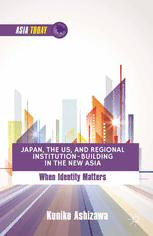
Japan, the US, and Regional Institution-Building in the New Asia: When Identity Matters PDF
Preview Japan, the US, and Regional Institution-Building in the New Asia: When Identity Matters
Japan, the US, and Regional Institution-Building in the New Asia ASIA TODAY Before 1820, Asia generated more than half of the world’s gross domestic product. Since then, the region underwent a period of decay and decline. Today, Asia is in the midst of a great transformation, and it is estimated that by 2035 it will be respon- sible for more than one half of the world’s gross domestic product. Propelled by three decades of rapid economic growth, momentous political transitions, and intensified regional integration, Asia is no longer simply a fast-expanding and evolving region; it is increasingly the geopolitical epicenter for the global system itself. The goal of this series is to offer readers a front-row seat to view and better understand this kaleido- scope of regional change in all its dazzling dynamism and diversity. Who would have thought in 1978, when Deng Xiaoping came to power in Beijing, that China would soon begin a generation of double-digit economic growth? Who could have foreseen that Asia would become the region where the world’s richest countries, Singapore and Brunei, would live shoulder-to-shoulder with the world’s poorest, Afghanistan and Laos? The Asia Today series is designed to respond to the growing demand for sus- tained research and deep knowledge of contemporary Asia. It covers the full expanse of this vast region—from China to India, Japan to Pakistan, Kazakhstan to Turkey, Mongolia to Israel, Iraq to Indonesia. The series editors, Takashi Inoguchi and G. John Ikenberry, aided by a 44-member advisory board, are dedicated to identifying fresh and penetrating studies of Asia by the region’s foremost experts. Series Editors Takashi Inoguchi, Professor Emeritus, University of Tokyo and President, University of Niigata Prefecture, Japan G. John Ikenberry, the Albert G. Milbank Professor of Politics and International Affairs, Princeton University, Department of Politics, and the Woodrow Wilson School of Public and International Affairs Published by Palgrave Macmillan: Political Parties and Democracy: Contemporary Western Europe and Asia Edited by Takashi Inoguchi and Jean Blondel The Troubled Triangle: Economic and Security Concerns for the United States, Japan, and China Edited by Takashi Inoguchi and G. John Ikenberry Japan, the US, and Regional Institution-Building in the New Asia: When Identity Matters By Kuniko Ashizawa Japan, the US, and Regional Institution-Building in the New Asia When Identity Matters Kuniko A shizawa J APAN, THEUS, ANDREGIONALINSTITUTION-BUILDINGINTHENEWASIA Copyright © Kuniko Ashizawa, 2013. Softcover reprint of the hardcover 1st edition 2013 978-1-137-30773-6 All rights reserved. First published in 2013 by PALGRAVE MACMILLAN® in the United States— a division of St. Martin’s Press LLC, 175 Fifth Avenue, New York, NY 10010. Where this book is distributed in the UK, Europe and the rest of the world, this is by Palgrave Macmillan, a division of Macmillan Publishers Limited, registered in England, company number 785998, of Houndmills, Basingstoke, Hampshire RG21 6XS. Palgrave Macmillan is the global academic imprint of the above companies and has companies and representatives throughout the world. Palgrave® and Macmillan® are registered trademarks in the United States, the United Kingdom, Europe and other countries. ISBN 978-1-349-45564-5 ISBN 978-1-137-30774-3 (eBook) DOI 10.1057/9781137307743 Library of Congress Cataloging-in-Publication Data Ashizawa, Kuniko, 1963– Japan, the US, and regional institution-building in the new Asia : when identity matters / Kuniko Ashizawa. pages cm 1. East Asia—Foreign economic relations. 2. Regionalism (International organization)—East Asia. 3. United States—Foreign economic relations. 4. Japan—Foreign economic relations. I. Title. HF1600.5.A837 2012 337.5205—dc23 2013007315 A catalogue record of the book is available from the British Library. Design by Newgen Knowledge Works (P) Ltd., Chennai, India. First edition: August 2013 10 9 8 7 6 5 4 3 2 1 To my Parents This page intentionally left blank Contents List of Figures and Tables ix Acknowledgments xi List of Abbreviations xv 1 Introduction 1 2 The Value-Action Framework and State Identity 15 3 Japan and the Creation of APEC: MITI’s Quiet Maneuver, 1988–1989 39 4 The United States and the Creation of APEC: Global Hegemon and Regional Cooperation, 1988–1989 81 5 J apan and the Creation of the ARF: MOFA in Motion, 1991–1994 1 23 6 The United States and the Creation of the ARF: Hegemonic Approach toward the Post–Cold War Asian Security Order, 1990–1994 1 61 7 Conclusion 195 Notes 211 Bibliography 2 43 Index 259 This page intentionally left blank Figures and Tables Figures 2.1 Value-action framework of foreign policy analysis 16 2.2 US and Japanese foreign policymaking toward APEC/ARF 17 Tables 1.1 Concept of State Identity, Values, and Preferences 5 1.2 Structural Attributes and Structurally-Disposed Orientation 6 3.1 Comparison of National Powers of Japan and United States, 1988–89 48 4.1 US Exports and Imports by Region, 1987–89 87 4.2 US Military Personnel on Active Duty in Foreign Countries in 1989 88 5.1 Comparison of National Powers of Japan and United States, 1990–93 130 6.1 US Exports and Imports by Region, 1990–93 168 6.2 US Military Personnel on Active Duty in Foreign Countries in 1991 169
